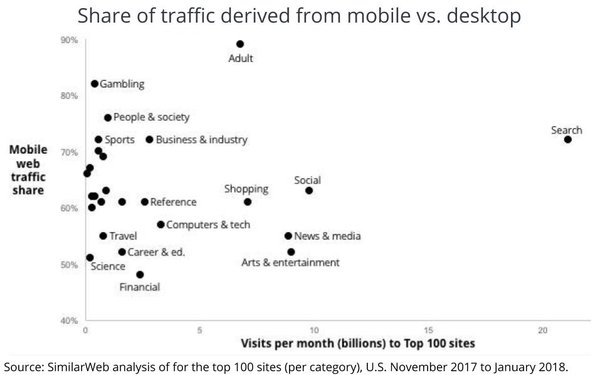Commentary
Our Phones, Our Computers, Ourselves: What Our Devices Know About Us
- by Stephen Kraus , Op-Ed Contributor, May 10, 2018

Consumers live multi-device lifestyles, and decide many times a day which device to use for specific digital tasks. Understanding this “allocation” of activities provides insights into consumers, and guides strategies for connecting with them more effectively.
Obviously smartphones use has been growing for many years, but there is still more room for expansion. Statcounter reports that it was only in the fourth quarter of 2016 that smartphones accounted for a greater share of global Internet usage than desktops, and the mix has now stabilized at about 52% smartphone, 44% desktop and 4% tablet (not including app usage, which is obviously almost exclusively phone-based). Segments and geography obviously matter as well -- mobile use is heavier among younger consumers and in the developing world (e.g., our data show that India’s traffic is more than 80% mobile), while consumers in Russia and eastern Europe skew closer to an even mix of mobile and desktop.
Across countries, how people choose devices for specific tasks provides insights into the digital customer journey. In a very real sense, our different devices know different aspects of our lives. Only by putting it all together do we get a complete picture of how consumers interact with the digital world.
Our phones know where we are. Our computers know where we want to go.
Studies have found that ~90% of consumers keep their location services turned on, and seeking out location-related information (such as nearby restaurants) frequently tops the list of most common smartphone uses. Still, consumers (and marketers) are just now developing the habit of leveraging location-based information -- Google Trends shows that use of the keyword phrase “near me” has more than doubled in the past year. Our phones know where we are, but our computers know better where we plan to go, and where we aspire to go. Travel as a category skews less mobile than many categories, driven by consumers preferring computers for extended research sessions and for making transactions.
Our phones know our secrets and vices. Our computers know our public personas.
Almost 90% of traffic to adult websites is mobile, with gambling sites close behind. Texting feels like the personal and intimate forum for communication. Our phones know our secrets, and the desires we won’t even tell our spouses. Our computers better know our public face -- LinkedIn traffic skews about two-thirds desktop, while Facebook skews two-thirds mobile.
Our phones know what we skim, and our snackable media preferences. Our computers know what we binge watch and study.
After the “vice” categories of adult and gambling, the next most mobile skewing categories include our snackable media consumption related to sports and “people and society” (e.g., celebrity news). Among the least mobile-skewing is “arts and entertainment” -- a category led by YouTube and streaming services such as Netflix. Study-heavy categories such as science and news also skew less mobile.
Our phones know what we shop for. Our computers know what we buy.
Consumers do a great deal of product research on their phones, but most purchases still happen on computers. In the U.S., three-fourths of e-commerce transactions take place on computers, and transaction-heavy Amazon is 52% mobile -- below average for the shopping category.
Our phones are about instant gratification. Computers are about delayed gratification.
Our phones are about what is right here, right now. A restaurant that is open and nearby, with directions to get there. Texting is the medium where we expect the fastest response. In contrast, you typically wait to get home to use your computer; you use it to buy things that will arrive later, and to invest for the future.


